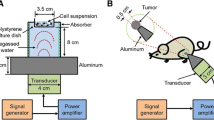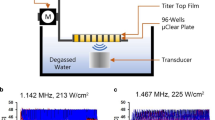Abstract
Purpose
The purpose of the present study is to investigate anticancer efficacy and apoptosis confirmed by caspase under several exposure conditions of high-intensity focused ultrasound (HIFU).
Materials and methods
Twenty-five rats with KDH-8 hepatoma were treated by HIFU at several acoustic energies to evaluate treatment efficacy. Apoptosis was examined by terminal deoxynucleotidyl transferase-mediated dUTP nick-end labeling (TUNEL) and Hoechst 33258 staining, and caspase 3, 8, and 9/6 activity was respectively assayed.
Results
The KDH-8 subcutaneous tumors were reduced by HIFU, and these rats survived longer than the nontreatment rats (P < 0.01). The minimal threshold of HIFU energy was 30 W × 1.0 s for tumor control and long-term survival. The tumors exposed to HIFU exhibited marked apoptotic features under conditions of less than 10 W × 1.0 s. In cultured KDH-8 cells, apoptosis was caused at less than 30 W × 1.0 s (P < 0.01), and more was induced as the energy went down. Caspase 3, 8, and 9/6 were more activated at low energy under 10 W × 1.0 s (P < 0.01), and caspase 8, which is death receptor dependent, was significantly more activated than caspase 9/6, which is mitochondria dependent (P < 0.01).
Conclusion
HIFU-induced apoptosis in vivo and in vitro is one of the mechanisms for tumor control and is mediated by caspase 3, 8, and 9/6. The significantly greater activation of caspase 8 than of caspase 9/6 suggests that the apoptosis pathway induced by HIFU might be more mitochondria dependent than death receptor dependent. However, further examination will be needed.





Similar content being viewed by others
Abbreviations
- HIFU:
-
High-intensity focused ultrasound
- SPTA:
-
Spatial peak temporal average
- TUNEL:
-
Terminal deoxynucleotidyl transferase-mediated dUTP nick-end labeling
References
Chapelon JY, Margonari J, Vernier F, et al. In vivo effects of high-intensity ultrasound on prostatic adenocarcinoma Dunning R3327. Cancer Res. 1992;52:6353–7.
ter Haar G, Rivens I, Chen L, et al. High intensity focused ultrasound for the treatment of rat tumours. Phys Med Biol. 1991;36:1495–501.
Yang R, Reilly CR, Rescorla FJ, et al. High-intensity focused ultrasound in the treatment of experimental liver cancer. Arch Surg. 1991;126:1002–9. discussion 9-10.
Lele PP. Advanced ultrasonic techniques for local tumor hyperthermia. Radiol Clin North Am. 1989;27:559–75.
Fry FJ, Johnson LK. Tumor irradiation with intense ultrasound. Ultrasound Med Biol. 1978;4:337–41.
ter Haar GR, Robertson D. Tissue destruction with focused ultrasound in vivo. Eur Urol. 1993;23(Suppl 1):8–11.
Chen L, Rivens I, ter Haar G, et al. Histological changes in rat liver tumours treated with high-intensity focused ultrasound. Ultrasound Med Biol. 1993;19:67–74.
Honda H, Zhao QL, Kondo T. Effects of dissolved gases and an echo contrast agent on apoptosis induced by ultrasound and its mechanism via the mitochondria-caspase pathway. Ultrasound Med Biol. 2002;28:673–82.
Ashush H, Rozenszajn LA, Blass M, et al. Apoptosis induction of human myeloid leukemic cells by ultrasound exposure. Cancer Res. 2000;60:1014–20.
Green DR. Apoptotic pathways: paper wraps stone blunts scissors. Cell. 2000;102:1–4.
Hengartner MO. The biochemistry of apoptosis. Nature. 2000;407:770–6.
Reed JC. Mechanisms of apoptosis. Am J Pathol. 2000;157:1415–30.
Tang W, Liu Q, Wang X, et al. Involvement of caspase 8 in apoptosis induced by ultrasound-activated hematoporphyrin in sarcoma 180 cells in vitro. J Ultrasound Med. 2008;27:645–56.
Yuan L, Kuramitsu Y, Li Y, et al. Restoration of interleukin-2 production in tumor-bearing rats through reducing tumor-derived transforming growth factor beta by treatment with bleomycin. Cancer Immunol Immunother. 1995;41:355–62.
Arefiev A, Prat F, Chapelon JY, et al. Ultrasound-induced tissue ablation: studies on isolated, perfused porcine liver. Ultrasound Med Biol. 1998;24:1033–43.
Sibille A, Prat F, Chapelon JY, et al. Characterization of extracorporeal ablation of normal and tumor-bearing liver tissue by high intensity focused ultrasound. Ultrasound Med Biol. 1993;19:803–13.
Kennedy JE, Wu F, ter Haar GR, et al. High-intensity focused ultrasound for the treatment of liver tumours. Ultrasonics. 2004;42:931–5.
Luo W, Zhou X, Gong X, et al. Study of sequential histopathologic changes, apoptosis, and cell proliferation in rabbit livers after high-intensity focused ultrasound ablation. J Ultrasound Med. 2007;26:477–85.
Vera Y, Diaz-Romero M, Rodriguez S, et al. Mitochondria-dependent pathway is involved in heat-induced male germ cell death: lessons from mutant mice. Biol Reprod. 2004;70:1534–40.
Hikim AP, Lue Y, Yamamoto CM, et al. Key apoptotic pathways for heat-induced programmed germ cell death in the testis. Endocrinology. 2003;144:3167–75.
Firestein F, Rozenszajn LA, Shemesh-Darvish L, et al. Induction of apoptosis by ultrasound application in human malignant lymphoid cells: role of mitochondria-caspase pathway activation. Ann N Y Acad Sci. 2003;1010:163–6.
Feril LB Jr, Kondo T, Zhao QL, et al. Enhancement of ultrasound-induced apoptosis and cell lysis by echo-contrast agents. Ultrasound Med Biol. 2003;29:331–7.
Miller DL, Pislaru SV, Greenleaf JE. Sonoporation: mechanical DNA delivery by ultrasonic cavitation. Somat Cell Mol Genet. 2002;27:115–34.
Miller DL, Thomas RM. Ultrasound contrast agents nucleate inertial cavitation in vitro. Ultrasound Med Biol. 1995;21:1059–65.
Tran BC, Seo J, Hall TL, et al. Microbubble-enhanced cavitation for noninvasive ultrasound surgery. IEEE Trans Ultrason Ferroelectr Freq Control. 2003;50:1296–304.
Kennedy JE, ter Haar GR, Wu F, et al. Contrast-enhanced ultrasound assessment of tissue response to high-intensity focused ultrasound. Ultrasound Med Biol. 2004;30:851–4.
Hotta N, Tagaya T, Maeno T, et al. Advanced dynamic flow imaging with contrast-enhanced ultrasonography for the evaluation of tumor vascularity in liver tumors. Clin Imaging. 2005;29:34–41.
Author information
Authors and Affiliations
Corresponding author
About this article
Cite this article
Hirokawa, N., Koito, K., Okada, F. et al. High-intensity focused ultrasound induced apoptosis with caspase 3, 8, and 9/6 activation in rat hepatoma. J Med Ultrasonics 36, 177–185 (2009). https://doi.org/10.1007/s10396-009-0234-2
Received:
Accepted:
Published:
Issue Date:
DOI: https://doi.org/10.1007/s10396-009-0234-2




